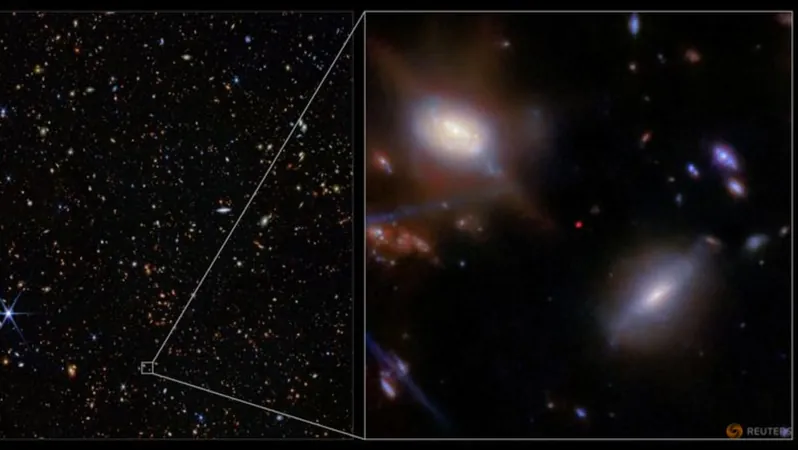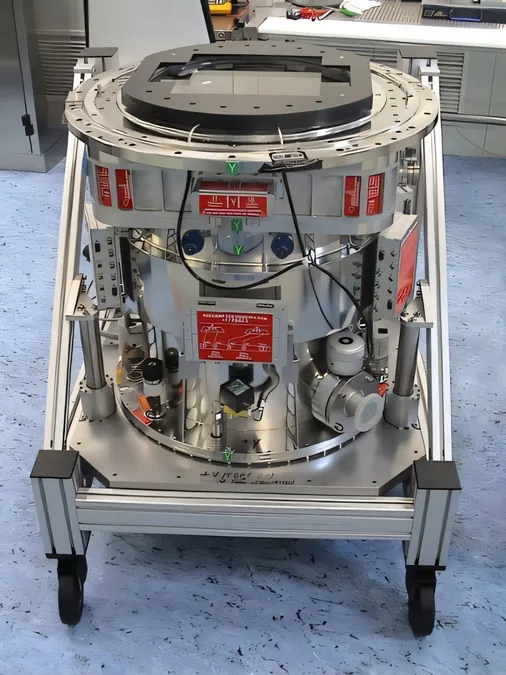
Groundbreaking Discovery: Webb Telescope Unveils Galaxy That Challenges Our Understanding of the Early Universe!
2025-03-26
Author: Wei
Groundbreaking Discovery: Webb Telescope Unveils Galaxy That Challenges Our Understanding of the Early Universe!
In a remarkable breakthrough, scientists utilizing the James Webb Space Telescope (JWST) have discovered a distant galaxy that could reshape our comprehension of the universe's evolution. Named JADES-GS-z13-1, this ancient celestial body existed just 330 million years post-Big Bang—much earlier than previously believed—illuminating a significant transitional phase that heralded the end of the universe's "dark ages."
The universe, which emerged approximately 13.8 billion years ago, underwent a rapid expansion shortly after the Big Bang. As it cooled, it experienced a phase known as the cosmic dark ages, characterized by a thick curtain of neutral hydrogen gas that obscured light and kept the universe in a state of darkness. However, scientists now posit that JADES-GS-z13-1 played a pivotal role in leading the cosmos into the epoch of reionization—an era when the universe began to radiate light from its first stars and galaxies.
Astrophysicist Joris Witstok from the University of Copenhagen highlights the significance of this discovery: "JADES-GS-z13-1 stands out as one of the most distant galaxies identified to date. Its unmistakable signature suggests a powerful source of energetic ultraviolet radiation, indicating a surprisingly early onset of reionization." This phenomenon is critical as it marked the transition when the universe became 'lit up', facilitating the escape of ultraviolet light and altering the state of hydrogen in the process.
The cosmic dawn, a period when the universe saw the birth of its first stars, black holes, and galaxies, coincided with the intense ultraviolet radiation emitted by these objects, which eventually stripped electrons from neutral hydrogen atoms. Over millions of years, this led to a transformed universe, one that became transparent to ultraviolet light—an essential evolution in cosmic history.
The intricate process leading to reionization, as expounded by co-author Kevin Hainline from the University of Arizona, involved the gradual agglomeration of hydrogen, helium, and dark matter as they cooled. "Initially, the universe was opaque to energetic ultraviolet radiation, but as stars and supermassive black holes began forming, they emitted ultraviolet light that gradually transformed the universe," said Hainline.
Interestingly, the JWST's data suggests that JADES-GS-z13-1, measuring a mere 230 light-years across—far smaller than the Milky Way—hosts vibrant star formation potentially influenced by a rapidly growing supermassive black hole consuming neighboring materials.
Since its launch in late 2021 and subsequent operational debut in 2022, Webb has been revolutionizing our understanding of cosmic history. It has identified a handful of galaxies existing shortly after the Big Bang, although none exhibited evidence of reionization until now. The findings from JADES-GS-z13-1 surprised researchers, revealing a significant ionized hydrogen bubble surrounding the galaxy—indications that counter existing theories that suggested reionization began much later.
"We now face a captivating mystery," elaborated Witstok. "Previous measurements indicated that reionization was not fully completed until the universe reached about one billion years old, which is 700 million years after the time of this galactic discovery." This work propels a crucial inquiry into when reionization truly commenced and adds profound depth to the study of our universe's infancy.
With each revelation from the JWST, we inch closer to unraveling the complex tapestry of cosmic history, as the quest to understand our universe intensifies. What other secrets lie in wait beyond the cosmic veil?





 Brasil (PT)
Brasil (PT)
 Canada (EN)
Canada (EN)
 Chile (ES)
Chile (ES)
 Česko (CS)
Česko (CS)
 대한민국 (KO)
대한민국 (KO)
 España (ES)
España (ES)
 France (FR)
France (FR)
 Hong Kong (EN)
Hong Kong (EN)
 Italia (IT)
Italia (IT)
 日本 (JA)
日本 (JA)
 Magyarország (HU)
Magyarország (HU)
 Norge (NO)
Norge (NO)
 Polska (PL)
Polska (PL)
 Schweiz (DE)
Schweiz (DE)
 Singapore (EN)
Singapore (EN)
 Sverige (SV)
Sverige (SV)
 Suomi (FI)
Suomi (FI)
 Türkiye (TR)
Türkiye (TR)
 الإمارات العربية المتحدة (AR)
الإمارات العربية المتحدة (AR)